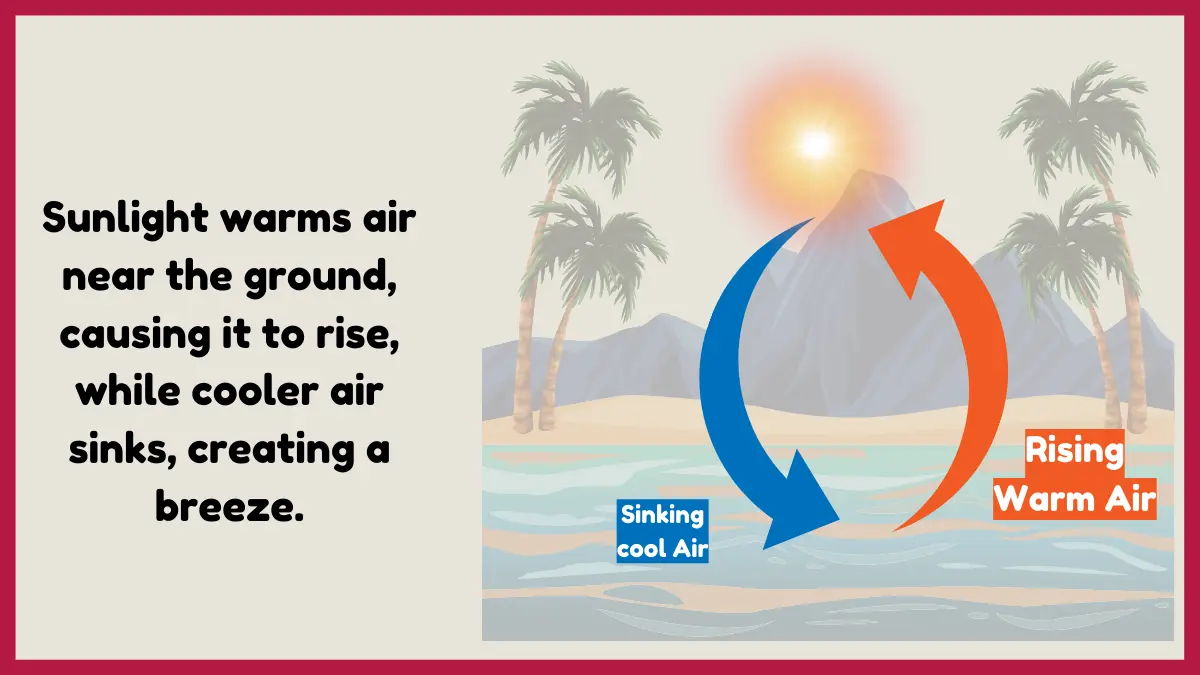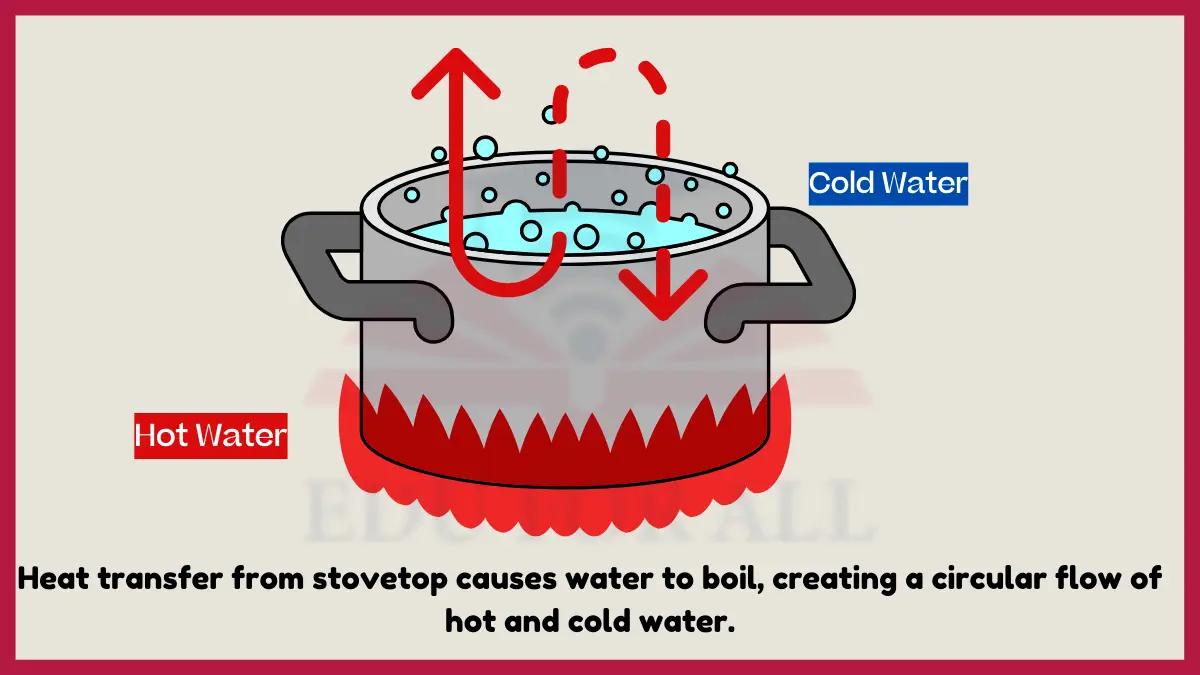Convection is the transfer of heat through the movement of a fluid, such as water or air. This can be seen in many everyday examples, such as the boiling of water, the circulation of air in a radiator, the rise of a hot air balloon, the cooking of food in a convection oven, and the generation of electricity in a solar panel.
Also Read: Examples of Conduction
- Examples of Convection
- 1. Hot Air Rising
- 2. Natural Air Currents
- 3. Ocean Currents
- 4. Boiling Water
- 5. Cooking with Convection Ovens
- 6. Car Radiator
- 7. Natural Ventilation
- 8. Mantle Convection
- 9. Weather Systems
- 10. Blood Circulation
- 11. Air Conditioner
- 12. Radiator
- 13. Refrigerator
- 14. Hot Air Popper
- 15. Hot Air Balloon
- 16. Hot Beverage
- 17. Rainfall & Thunderstorms
- 18. Air-Cooled Engines
- 19. Melting Ice
Examples of Convection
Here are the examples of convection:
1. Hot Air Rising
Hot air rising from a radiator or heat vent is convection. As the air is heated by the radiator, it expands, becomes less dense than the surrounding cooler air, and rises upward. The cooler denser air then sinks down to take its place, creating a continuous loop of circulating air currents. This motion of heated air rising and cooler air sinking is convection at work.
2. Natural Air Currents
Air movements outside like breezes and winds are the result of convection. The sun heating the Earth’s surface warms the air above it. This warmer lighter air rises upward while the cooler denser air nearby flows in horizontally to displace it. The pattern of warm air rising and cooler air sinking creates natural convection currents seen as breezes.

3. Ocean Currents
The global ocean conveyor belt circulates water around the globe through convection. Cold dense saltwater sinks in polar regions. As it sinks downward, warmer water from lower depths rises up vertically to take its place. This creates large-scale circulation patterns driven by the convection of cold polar water sinking and warmer water rising.
4. Boiling Water
Bubbles rising and churning in boiling water demonstrate convection at work. As heat is applied to the bottom of the pot, the water expands, decreases in density, and rises upward in plumes and eddies. At the same time, cooler denser water sinks down to replace it. This cycling of hot rising and cool sinking water is convection.

5. Cooking with Convection Ovens
Convection ovens use a fan to circulate hot air around food. The fan blows the hot air so that it contacts the food, transfers heat, then rises and is blown again. This cycling of hot air currents transferring heat by convection allows food to cook faster.
The cycling of hot air rising, transferring heat, and cooler air sinking allows more efficient heat transfer.
6. Car Radiator
A car radiator uses convection to cool the engine. Hot coolant from the engine becomes less dense as it absorbs heat. It rises into the radiator top while the denser cooled fluid sinks down. This continuous cycling of hot fluid rising and cooler fluid sinking creates convection currents.
7. Natural Ventilation
Opening windows allows convection currents to ventilate a room. The warm interior air rises and escapes outside through upper openings, being replaced by cooler denser exterior air flowing inward at lower openings. The cycling of warm air rising and cool air sinking ventilates through convection.
8. Mantle Convection
Heat from Earth’s core causes slow convection currents in the mantle. Mantle rocks are heated until less dense, then rise toward the surface. As they rise, they cool, become denser, and eventually sink again. This cycling of hot mantle rock rising and cool rock sinking drives convection.
9. Weather Systems
On a large scale, convection creates weather systems. Warm moist air over equatorial regions rises, moves poleward, cools, condenses moisture, and sinks. The cool dense air then flows back toward the equator. This global convection loop circulates heat.
10. Blood Circulation
Warm blood flowing from the heart throughout the body and back again relies on convection. Blood picks up body heat and becomes less dense, flowing outward through arteries. It then cools, becoming denser, and sinks back through veins. This circulating flow is driven by convection.
11. Air Conditioner
An air conditioner uses convection to circulate and cool air. A fan blows air over cold coils which cools and densifies it. This heavy cool air then sinks down into a room, forcing the warmer lighter air up and out through vents. This air cycling is convection.
12. Radiator
A radiator uses convection to heat a room. Hot water inside expands, becomes less dense, and rises to the top. This displaces the cooler denser water at the top, forcing it down. The cycling of hot water rising and cool water sinking spreads heating through convection.
13. Refrigerator
A refrigerator relies on convection to cool its interior. A fan circulates chilled air which becomes dense and sinks down. As it sinks, warmer lighter air is forced up to be cooled again, cycling air through convection currents.
14. Hot Air Popper
Hot air poppers use a fan to create convection currents, blowing hot air up through kernels. This less dense heated air rises and lifts the light popped popcorn up with it, demonstrating convection in action.
15. Hot Air Balloon
Hot air balloons rise due to convection. The burner heats the air inside, causing it to expand and become less dense than the cooler air outside. The buoyant hot air creates upward lift, while dense cool air sinks around it.

16. Hot Beverage
Steam and heat rising from a hot beverage demonstrate convection. The hot water evaporates, becoming less dense water vapor that rises upward. As the steam rises, denser cooler air sinks down to replace it. This motion allows for more evaporation.
17. Rainfall & Thunderstorms
On a large scale, convection creates rainfall and thunderstorms. Warm moist air rises, cools, condenses moisture into clouds and precipitation as denser air sinks down. This cycle of rising warm air and sinking cool air is convection.
18. Air-Cooled Engines
Air-cooled engines rely on convection to disperse heat. Fins conduct heat away into passing air. This less dense warmer air then naturally rises due to convection, pulling cooler denser replacement air behind it.
19. Melting Ice
As ice melts, convection occurs because the cold dense meltwater sinks downward while the warmer buoyant water rises up. This cycling motion of cold water sinking and warm water rising causes convection currents.

